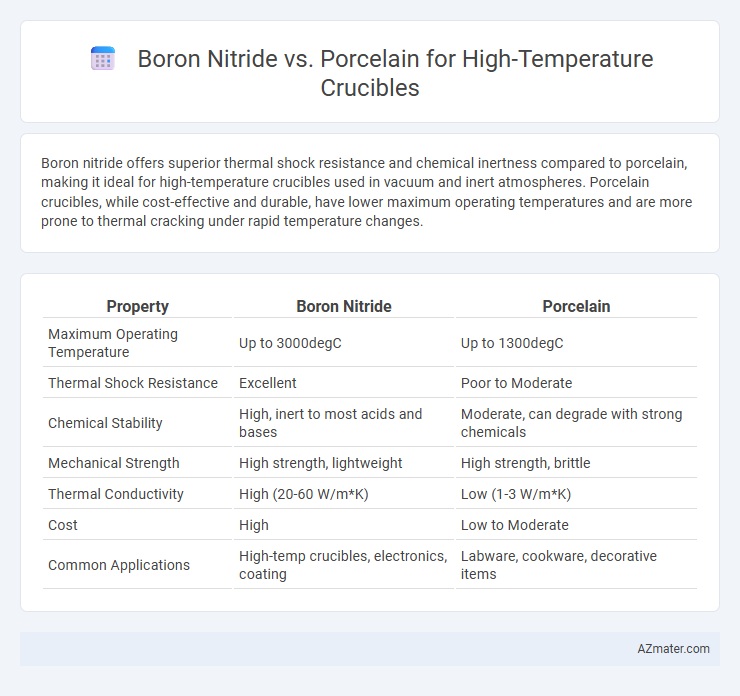Boron nitride offers superior thermal shock resistance and chemical inertness compared to porcelain, making it ideal for high-temperature crucibles used in vacuum and inert atmospheres. Porcelain crucibles, while cost-effective and durable, have lower maximum operating temperatures and are more prone to thermal cracking under rapid temperature changes.
Table of Comparison
| Property | Boron Nitride | Porcelain |
|---|---|---|
| Maximum Operating Temperature | Up to 3000degC | Up to 1300degC |
| Thermal Shock Resistance | Excellent | Poor to Moderate |
| Chemical Stability | High, inert to most acids and bases | Moderate, can degrade with strong chemicals |
| Mechanical Strength | High strength, lightweight | High strength, brittle |
| Thermal Conductivity | High (20-60 W/m*K) | Low (1-3 W/m*K) |
| Cost | High | Low to Moderate |
| Common Applications | High-temp crucibles, electronics, coating | Labware, cookware, decorative items |
Introduction to High-Temperature Crucible Materials
Boron nitride and porcelain are prominent materials for high-temperature crucibles, each offering distinct thermal and chemical properties essential in industrial applications. Boron nitride excels with exceptional thermal stability up to 3000degC, chemical inertness, and excellent thermal shock resistance, making it ideal for use in metallurgical processes and semiconductor manufacturing. Porcelain, while more cost-effective, provides good thermal resistance up to around 1300degC but has lower mechanical strength and thermal shock resistance compared to boron nitride, limiting its use in ultra-high temperature scenarios.
Overview of Boron Nitride Properties
Boron nitride exhibits exceptional thermal stability with a melting point above 2973degC, making it ideal for high-temperature crucibles used in metal and ceramic processing. Its excellent chemical inertness and resistance to oxidation enhance durability under extreme conditions, while its low thermal expansion minimizes thermal shock risk. The material's high thermal conductivity facilitates efficient heat distribution, improving performance compared to porcelain crucibles at elevated temperatures.
Key Characteristics of Porcelain Crucibles
Porcelain crucibles exhibit excellent thermal shock resistance and chemical inertness, making them suitable for various high-temperature applications below 1200degC. Their dense, non-porous structure prevents contamination and ensures durability during repeated heating and cooling cycles. Unlike boron nitride, porcelain crucibles are more cost-effective but have lower thermal conductivity, which may affect the heating rate in some processes.
Thermal Stability: Boron Nitride vs Porcelain
Boron nitride exhibits superior thermal stability compared to porcelain, maintaining structural integrity at temperatures exceeding 2,000degC, while porcelain typically degrades above 1,400degC. The excellent thermal shock resistance of boron nitride prevents cracking during rapid temperature changes, unlike porcelain which is prone to thermal shock damage. Boron nitride's chemically inert nature also allows it to withstand aggressive environments at high temperatures where porcelain may chemically react or fracture.
Chemical Resistance and Reactivity
Boron nitride crucibles exhibit superior chemical resistance and inertness compared to porcelain, making them ideal for high-temperature applications involving reactive or corrosive substances such as molten metals and aggressive acids. Porcelain crucibles, while cost-effective, tend to react with alkaline materials and may degrade under extreme thermal stress, limiting their use in harsh chemical environments. The exceptional non-reactive nature and thermal stability of boron nitride ensure minimal contamination and longer crucible lifespan in demanding laboratory and industrial processes.
Mechanical Strength and Durability
Boron nitride crucibles exhibit superior thermal shock resistance and mechanical strength at elevated temperatures compared to porcelain, making them ideal for rapid heating and cooling cycles. Porcelain crucibles, while chemically stable, tend to be more brittle and prone to cracking under mechanical stress and thermal cycling. The high durability of boron nitride under extreme thermal and mechanical conditions enhances its longevity and reliability for high-temperature applications in laboratories and industry.
Suitability for Different Applications
Boron nitride crucibles are highly suitable for applications requiring exceptional thermal shock resistance, chemical inertness, and non-wettability with molten metals, making them ideal for advanced electronics and semiconductor processing. Porcelain crucibles excel in general laboratory use due to their cost-effectiveness, good heat resistance up to about 1200degC, and resistance to acids but are less suitable for extremely high-temperature environments or reactive molten materials. Choice between boron nitride and porcelain crucibles depends on the specific thermal requirements, chemical compatibility, and application precision needed.
Cost and Availability Comparison
Boron nitride crucibles typically have a higher cost due to their superior thermal shock resistance and chemical inertness, making them ideal for specialized high-temperature applications. Porcelain crucibles are more widely available and economically priced, suitable for standard laboratory use but limited in extreme temperature environments above 1000degC. Availability of boron nitride is more restricted and may require specialized suppliers, whereas porcelain crucibles are broadly accessible through common lab equipment distributors.
Maintenance and Longevity
Boron nitride crucibles offer superior resistance to thermal shock and chemical corrosion, resulting in lower maintenance requirements and extended longevity compared to porcelain crucibles. Porcelain crucibles can be prone to cracking under rapid temperature changes and may degrade faster when exposed to aggressive chemicals, necessitating frequent replacement. High-temperature applications benefit from boron nitride's exceptional durability and ease of cleaning, which support consistent performance over prolonged use.
Choosing the Right Crucible Material
Boron nitride crucibles offer superior thermal shock resistance and chemical inertness, making them ideal for high-temperature applications involving reactive materials. Porcelain crucibles provide excellent mechanical strength but have lower thermal conductivity and can crack under rapid temperature changes. Selecting the right crucible material depends on factors such as temperature range, chemical reactivity of the sample, and the need for thermal stability during the heating process.

Infographic: Boron nitride vs Porcelain for High-temperature Crucible
 azmater.com
azmater.com